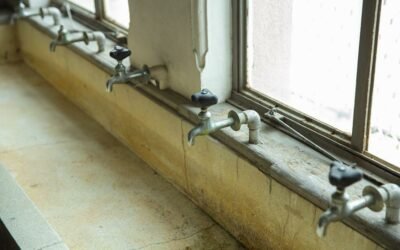Have you ever wondered if a roof leak can cause mold? The answer is yes! When water seeps through your roof, it can create the perfect environment for mold growth.
In this article, we will explore the connection between roof leaks and mold, the signs of mold growth caused by leaks, the health risks associated with mold infestation, and most importantly, how to prevent and remediate mold caused by roof leaks.
Stay informed and protect your home from this potential hazard.
Key Takeaways
- Roof leaks provide moisture for mold spores to thrive, creating an ideal environment for mold growth.
- Mold colonies can develop on various surfaces in the home, weakening the structural integrity of the property.
- Mold growth caused by roof leaks can be identified through signs such as musty odors, discoloration on walls or ceilings, and visible mold in colors like black, green, or brown.
- Mold infestation resulting from roof leaks can lead to health risks including respiratory problems, allergic reactions, and even neurological problems in severe cases.
The Connection Between Roof Leaks and Mold
If you have a roof leak, it can lead to the growth of mold in your home. The connection between roof leaks and mold is a serious concern that homeowners shouldn't overlook. When water enters your home through a roof leak, it creates the perfect environment for mold to thrive. Mold spores are naturally present in the air, and when they come into contact with moisture, they can start to grow and multiply rapidly. This can lead to the development of mold colonies on various surfaces, such as walls, ceilings, and even furniture.
Mold not only poses a health risk but can also cause significant damage to your property. It can weaken the structural integrity of your home, leading to costly repairs. Additionally, mold can trigger allergic reactions, respiratory problems, and other health issues, especially in individuals with compromised immune systems or allergies.
It is essential to address roof leaks promptly to prevent the growth and spread of mold. Regular roof inspections and maintenance can help identify and fix any potential leaks before they cause significant damage. Additionally, make sure your attic is properly ventilated to reduce moisture buildup.
If you suspect mold growth, it's crucial to hire a professional mold remediation specialist to assess the situation and safely remove the mold from your home. Taking these preventive measures can help protect your home and your health from the harmful effects of mold.
Signs of Mold Growth Caused by Roof Leaks
Wondering how to identify if your roof leak has caused mold growth in your home? It's important to be aware of the signs of mold growth that can be caused by roof leaks. By being vigilant and observant, you can catch the problem early and take the necessary steps to address it. Here are some common signs to look out for:
| Signs of Mold Growth | Explanation |
|---|---|
| Musty Odor | If you notice a persistent musty smell in your home, it could be a sign of mold growth. Even if you can't see any visible mold, the odor is often a clear indication of its presence. |
| Discoloration | Discoloration on your walls or ceilings, especially in areas where water stains are visible, can be a sign of mold growth. Mold can appear in various colors, including black, green, or brown, and can spread rapidly if left untreated. |
| Allergic Reactions | If you or your family members experience unexplained allergic symptoms such as sneezing, coughing, or itchy eyes, it could be due to mold spores in the air. Mold can trigger allergies and respiratory issues, so it's important to investigate the cause. |
These signs should not be ignored, as mold growth can have detrimental effects on both your health and the structural integrity of your home. If you suspect mold growth due to a roof leak, it is recommended to consult a professional mold remediation specialist to assess the situation and provide appropriate solutions.
Health Risks Associated With Mold Infestation
Now let's delve into the health risks that can be associated with a mold infestation caused by a roof leak.
Mold infestations can pose significant health risks to individuals living in affected homes. When mold spores are released into the air, they can be inhaled by occupants, leading to a range of health issues.
Respiratory problems are particularly common, with symptoms such as coughing, wheezing, and shortness of breath. Individuals with pre-existing respiratory conditions, such as asthma or allergies, may experience exacerbated symptoms.
Additionally, mold exposure can cause irritation of the eyes, nose, and throat, leading to itching, redness, and soreness. Some individuals may also develop skin rashes or experience headaches and fatigue.
Prolonged exposure to mold can even result in more serious health conditions, including chronic sinus infections, respiratory infections, and even neurological problems.
It's important to note that the severity of health risks can vary depending on the individual's sensitivity to mold and the extent of the infestation. Therefore, it's crucial to address mold issues promptly and seek professional remediation to mitigate health risks associated with mold infestation caused by a roof leak.
Preventing Mold From Roof Leaks
To prevent mold from roof leaks, you should regularly inspect your roof for any signs of damage or deterioration. Taking proactive measures to identify and address potential issues can help prevent mold growth and the associated health risks. Here are some steps you can take:
- Check for water stains: Look for any discoloration or water stains on your ceiling or walls. These can be indicative of a roof leak and potential mold growth.
- Keep gutters clean: Ensure that your gutters are free from debris and properly functioning. Clogged gutters can cause water to overflow onto your roof, leading to leaks and mold.
- Trim surrounding trees: Overhanging tree branches can rub against your roof and cause damage, creating entry points for water. Regularly trim back any branches that are too close to your roof.
- Maintain proper attic ventilation: Adequate airflow in your attic helps to prevent moisture buildup, reducing the risk of mold growth. Make sure vents are clean and unobstructed.
Remediation Steps for Mold Caused by Roof Leaks
To effectively address mold caused by roof leaks, you need to take immediate action to mitigate the damage and prevent further spread. Mold can quickly grow and spread in damp environments, causing not only damage to your property but also potential health risks. Here are the key steps you should take for mold remediation caused by roof leaks:
| Remediation Steps | Emotional Impact |
|---|---|
| Identify the source of the leak | Relief |
| Fix the roof leak | Reassurance |
| Dry out the affected area | Hope |
| Clean and remove the mold | Satisfaction |
The first step is to identify the source of the leak. This will help you prevent future mold growth by repairing the roof and preventing further water intrusion. Once the leak is fixed, it is crucial to dry out the affected area. Use dehumidifiers, fans, and proper ventilation to remove excess moisture. Next, clean and remove the mold using appropriate cleaning products and techniques. It is important to wear protective gear, such as gloves and masks, to avoid exposure to mold spores. Properly disposing of contaminated materials is also essential to prevent recontamination. Following these remediation steps will help you effectively address mold caused by roof leaks and ensure a safe and healthy environment.
Conclusion
In conclusion, it's crucial to address roof leaks promptly to prevent mold growth. Roof leaks provide the ideal conditions for mold to thrive, leading to potential health risks and structural damage.
Recognizing the signs of mold growth caused by roof leaks is essential for early detection and remediation. By implementing preventive measures and promptly addressing any leaks, homeowners can effectively mitigate the risk of mold infestation and maintain a safe and healthy living environment.






0 Comments